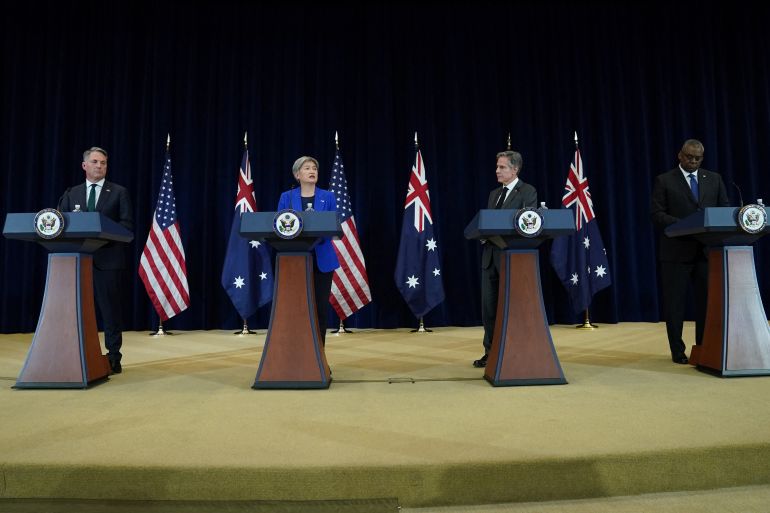US to send more troops to Australia, invite Japan to joint drills
Lloyd Austin says US will increase rotational presence of air, land and sea forces in Australia amid shared concerns over China.

The United States and Australia have agreed to deepen defence ties, including by increasing the rotational presence of US air, land and sea forces in the Oceanic country, citing shared concerns over China’s actions around Taiwan and in the East and South China Seas.
The announcement on Tuesday followed talks between the top US and Australian defence and diplomatic officials in Washington, DC.
Keep reading
list of 4 itemsEU, Western Balkans leaders meet amid fears of Russian influence
EU, G7, Australia to cap price on Russian oil at $60 per barrel
Australia says law making Google pay for news a ‘success’
“Today, we agreed to deepen our defence cooperation in several important ways,” US Defense Secretary Lloyd Austin told a joint news conference with his Australian counterpart, Richard Marles, that also included the two nations’ foreign ministers.
“Based upon today’s talks, we will increase rotational presence of US forces in Australia. That includes rotations of bomber task forces, fighters and future rotations of US Navy and US Army capabilities,” he said.
The two countries have also agreed to “invite Japan to integrate into our force posture initiatives in Australia”, he said.
Austin cited China’s rise and Russia’s invasion of Ukraine as the reasons for increased US-Australian defence ties.
“The United States and Australia share a vision of a region where countries can determine their own futures,” he said.
“Unfortunately, that vision is being challenged today. China’s dangerous and coercive actions throughout the Indo-Pacific, including around Taiwan, and toward the Pacific Island countries and in the East and South China Seas, threaten regional peace and stability,” he added.
In a joint statement following Tuesday’s talks, known as AUSMIN, the two sides said that “to strengthen US land presence,” they would expand locations for US Army and US Marine Corps forces in Australia. It said they would also identify priority locations to support the enhanced US presence with runway improvements, aircraft parking aprons and storage for fuel and munitions, as well as prepositioning stores, munitions and fuel.
Washington sees Canberra as a vital partner in its efforts to push back against China, and analysts say Australia could have a crucial logistical role to play in the defence of Taiwan against any move by Beijing to reclaim the strategic, self-administered island.
Australia’s Northern Territory is already host to frequent military collaborations with the US.
Thousands of US Marines rotate through the territory annually for training and joint exercises, and Washington is planning to deploy up to six nuclear-capable B-52 bombers to an air base in the region, according to Australian media.
Invitation to Japan
With an eye on China, the two countries also entered last year a three-way security pact — known as AUKUS — that will provide Canberra with the technology to deploy nuclear-powered submarines. The two sides said they had further discussions on the issue and that British Defence Minister Ben Wallace will attend a first in-person meeting of AUKUS ministers on Wednesday in Washington, DC.
Marles, the Australian defence minister, said Tuesday’s agreements would “see an increased level of activity between our two countries across all domains” and they were also looking at increased cooperation to enhance the capacity of facilities in Australia.
“It’s really important that we are doing this from the point of view of providing balance within our region and involving other countries within our region,” he said, adding that he and Foreign Minister Penny Wong would hold similar 2+2 talks with Japan in Tokyo later in the week “with an invitation for Japan to be participating in more exercises with Australia and the United States”.
Washington, Canberra and Tokyo have also worked together in recent years through the so-called Quad grouping that includes India.
Marles added that the US and Australia had taken steps on Tuesday “to create a more seamless defence industrial base” and that they needed to work together more closely “to enhance our military capability and to develop new technologies”.
The deepening of US-Australian defence ties comes as both nations look to ease tensions with China.
Their leaders held separate talks with Chinese President Xi Jinping at the sidelines of a G20 summit in Bali in November.
Following his meeting with Xi, US President Joe Biden said the two countries agreed on the need to cooperate on global challenges, including climate change and global food security, and had tasked their teams to maintain regular contact. As part of that effort, US Secretary of State Antony Blinken is set early next year to pay the first visit by a top US diplomat to Beijing in more than four years.
Australian Prime Minister Anthony Albanese, after his talks with Xi, also signalled the two countries would seek to move past years of disagreements over trade, human rights, the COVID-19 pandemic as well as Taiwan, the self-ruled island that China claims as part of its territory.
As the AUSMIN talks took place, a bipartisan group of Australian legislators visited Taiwan on Tuesday despite warnings from Beijing.
Wong, the Australian foreign minister, said in Washington, DC, that there should be “no unilateral change to the status quo” over Taiwan and that Canberra valued “our longstanding unofficial relationship with Taiwan”.